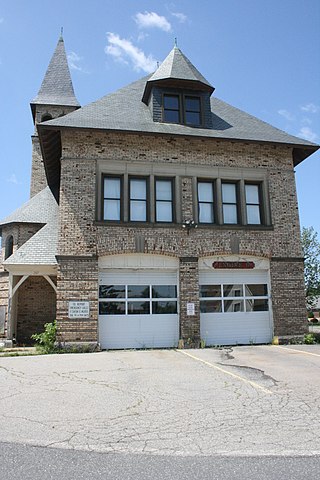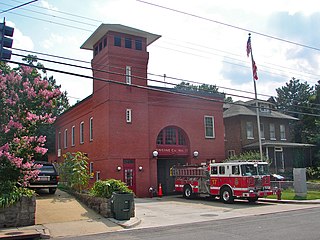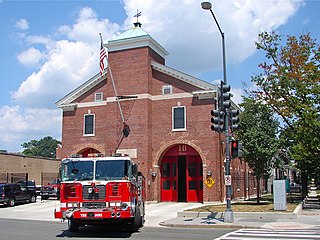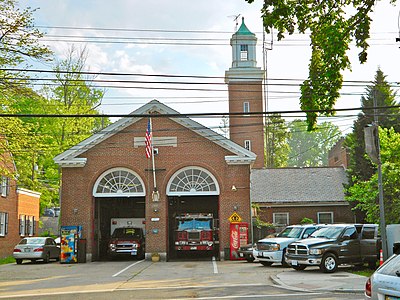
The Palisades, or simply Palisades, is a neighborhood in Washington, D.C., along the Potomac River, running roughly from the edge of the Georgetown University campus to the D.C.-Maryland boundary.

Engine House No. 6 is a historic firehouse at 480 Howard Street in Lawrence, Massachusetts. Built in 1895-96 to a design by John Ashton, the Colonial Revival brick building is the oldest firehouse building in the city, and its design was used in the development of other city fire stations. Shuttered by budget cuts in 2009, it was reopened in 2012, and continues to serve its original purpose. It was listed on the National Register of Historic Places in 2004.

Bloomingdale Firehouse, also known as the Brown Square Station, is a historic former firehouse at 267 Plantation Street/676 Franklin Street in Worcester, Massachusetts. Formerly home to the Worcester Fire Department's Engine Company 6, the building was built in 1895–96. It is a well-preserved example of Queen Anne and Colonial Revival styling. The building served as a firehouse until 2008, when it was replaced by a new station, located at 266 Franklin Street, the site of the well-known Worcester Cold Storage and Warehouse Co. fire. It was listed on the National Register of Historic Places in 1980. It has been converted into a private residence.

Engine Company No. 2 is a firehouse located at 1313 Washington Street in Hoboken, New Jersey, United States. The firehouse was added to the National Register of Historic Places on March 30, 1984.

The Niagara Engine House is located on North Hamilton Street in downtown Poughkeepsie, New York, United States. It is a brick building constructed in the early 20th century, the only extant fire house of the six engine companies that once protected the city.

The West End Hose Company Number 3 is a historic two-story brick firehouse located at 15 North Doughty Avenue in the borough of Somerville in Somerset County, New Jersey, United States. The building was added to the National Register of Historic Places on July 17, 2002 for its significance in architecture and social history. The building is currently the Somerville Fire Department Museum operated by the Somerville Exempt Firemen's Association.

The Engine Company 2 Fire Station is a firehouse at the corner of Main and Belden streets in Hartford, Connecticut, United States. It is a brick structure built in the early 20th century, the second firehouse built for the company. Architect Russell Barker, who designed many public buildings in the city, used the Italian Renaissance Revival style, unusual for a firehouse. The front facade boasts intricate brickwork. It is one of two remaining firehouses in the city originally designed to accommodate both men and horses. In 1989, it was added to the National Register of Historic Places along with several other city firehouses. It continues to serve its original function, housing Engine Company 2 of the Hartford Fire Department.

The Janney Elementary School is a public elementary school from Pre-K through 5th grade. A part of the District of Columbia Public Schools, it enrolls approximately 740 students.

Engine Company No. 17 also known as Chemical Company No. 4 and the Brookland Firehouse, is a historic firehouse located at 1227 Monroe Street, NE, Washington, D.C. It was constructed in 1902 and housed an early “chemical company” which fought fires in outlying districts using large soda-acid extinguishers rather than using steam pumpers on the unreliable municipal water supply. The firehouse was innovative at the time of its construction, having a built-in electrical system, and it was designed to make use of the new call box system installed in the neighborhood. It was officially designated Engine Company 17 in 1905.

The Vigilant Firehouse is a historic building in the Georgetown section of Washington, D.C. located at 1066 Wisconsin Ave., NW, just north of the Chesapeake and Ohio Canal and the Canal Monument. The Vigilant Fire Company was organized in 1817 and this firehouse was built in 1844, making it the oldest extant firehouse in the District of Columbia. It was listed on the National Register of Historic Places in 1971.

Truck House No. 13, also known as the Trinidad Firehouse is a historic firehouse located at 1342 Florida Ave. NE, Washington, D.C. It was built in 1925 and added to the United States National Register of Historic Places in 2007.

Fire Station No. 23 is a former fire station located in the Central District of Seattle, Washington listed on the National Register of Historic Places. It was remodeled as the Cherry Hill Community Center in 1970, and served as the headquarters of Centerstone. It was again renamed in 2018 to Byrd Barr Place. This was done to honor local US civil rights leader Roberta Byrd Barr, who is cited as strong supporter of CAMP's efforts since the 1960s. The location currently offers community support to the surrounding Seattle area, including housing assistance, tackling food insecurity, and bringing the community together to advocate for its needs. Byrd Bard Place seeks to support Black Washingtonian's within Seattle's Central District in particular, with the end goal of bettering the state of Washington collectively.

Engine Company No. 19 is a historic Engine house in Southeast Washington, D.C.'s Randle Highlands neighborhood. It was listed on the District of Columbia Inventory of Historic Sites in 2009 and it was listed on the National Register of Historic Places in 2010.

Engine Company 21, also known as the Lanier Heights Firehouse, is a fire station or firehouse and a historic structure located in the Lanier Heights neighborhood in Washington, D.C. It was listed on the District of Columbia Inventory of Historic Sites in 2005 and on the National Register of Historic Places in 2007. The building is attributed to local architect Appleton P. Clark, Jr., and built in 1908 in the Spanish Colonial Revival style. The station was built to serve the growing suburban areas of Washington north of Florida Avenue, NW. Because of its proximity to numerous multistory apartment buildings it housed the longest hook-and-ladder truck in the city.

Engine Company 31, also known as the Forest Hills Firehouse, is a fire station and an historic structure located in the Wakefield neighborhood in Washington, D.C. It was listed on both the DC Inventory of Historic Sites and on the National Register of Historic Places in 2011. The brick building was designed by Albert L. Harris and built in 1931.

Engine Company 12 is a former fire station and a historic structure located in the Bloomingdale neighborhood and on North Capitol Street in Washington, D.C. The engine company was established on July 1, 1897, with an 1884 Clapp & Jones 450 GPM steam fire engine and an 1887 E. B. Preston hose reel carriage. The three-story brick building was designed by Washington architect Snowden Ashford in the Colonial Revival style. It was listed on the National Register of Historic Places in 2007.

Truck Company F, at 1336-1338 Park Rd. NW in Washington, D.C., was built in 1900. It was listed on the National Register of Historic Places in 2007. The listing included two contributing buildings.

Albert L. Harris was an American architect who worked primarily in Washington, D.C. He was born in Wales and emigrated to the United States as a young child. He worked for architectural firms in Chicago and Baltimore and then Washington, where he also obtained an architectural degree from George Washington University. He was a part-time professor there while also working for the US Navy and then the city of Washington where he served as the city's Municipal Architect from 1921 until his death in 1933. A number of his works are listed on the National Register of Historic Places (NRHP).

The Excelsior Engine Co. No. 2 Firehouse is a historic former fire station built in 1897 and located at 6106 Polk Street in the town of West New York in Hudson County, New Jersey, United States. It was later known as the Exempt Firemen Association Headquarters. The building was added to the National Register of Historic Places on August 12, 2022, for its significance in architecture and social history. It was listed in 2017 as one of the state's 10 most endangered historic places by Preservation New Jersey.





















